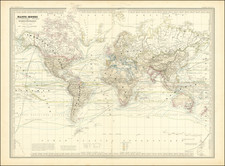Fine Example of the Circa 1802 Edition of Aaron Arrowsmith's First Map
Exceptional compilation of the best available information from the most recent explorations, including the most up to date information from voyages to the Northwest Coast of America, as well as the Arctic. This is a meticulously updated state of Arrowsmith’s first world map, first published in 1790.
When the map was first published in 1790, this map was not only Arrowsmith's first map, but also the first separately-issued English world map to show Cook's discoveries from all three of his voyages. The map is not simply an essential map for Cook collectors, but it also incorporates many other Pacific voyages, with approximately thirty exploration tracks marked, dating from 1492 to 1789, including the voyages of Furneaux, Surville, Tasman, Chirikov, Bering and others. For example, in the Arctic, Alexander MacKenzie's 1787-89 expedition is illustrated; this information derived directly from MacKenzie's own manuscript journal and pre-dates the 1801 publication of Mackenzie's Voyage.
Arrowsmith precisely incorporates the results of voyages by Meares, Portlock, Dixon and Duncan. Early issues of the map show the Northwest Coast as per those discoveries. However, on the present issue, Arrowsmith has corrected the mapping of the region around Queen Charlotte Islands to conform to Vancouver's discoveries and removed the references to Duncan. The present example is the first issue to incorporate those important discoveries.
As with the 1802 Arrowsmith “Map of North America,” this map shows the advanced state of knowledge of the Upper Missouri River which would be utilized by the explorers Lewis & Clark. It incorporates the reports of Peter Fidler for the Hudson's Bay Company by including a series of possible river courses to the west leading to (and prospectively through) the Rocky Mountains. It was this section of the map that provided the best depiction of the prospect of a water route or portage through the Rocky Mountains and to the Pacific. It was this information, along with reports from local Indians encountered on the expedition, which Lewis & Clark relied upon in choosing their path to the Rocky Mountains.
The map also provides a fine update on the state of knowledge for the coast of Australia. This is the first edition of the map to show Van Diemen's Land as detached from Australia.
As Bricker explains, "Clarity and accuracy were [Arrowsmith's] aims - and he achieved them as no English cartographer was able to before him. His maps are still essential to historians who want to delve into the history of the 18th-century exploration of the Pacific" (Bricker, Landmarks of Mapmaking, p. 98).
Scales of Calculation
The map is accompanied below by a large table which holds a series of scales. This table is intended to help readers calculate the distance between two points with only the latitude of the points and the bearing between them. It is intended to help to overcome the level of distortion inherent within a Mercator projection.
The Mercator projection is extremely helpful to navigators for it allows them to draw a course between departure and destination, on a constant bearing, with a straight line. It in effect simplifies the curve of the earth. However, this comes at the expense of a settled scale of latitude, which varies along its length in a Mercator chart. The distortion is the worst at high latitudes, which have been pulled apart to make the round globe into a rectangle chart. This makes it difficult to measure the distance between two points, except those that are on the same line of latitude that has a settled scale.
Here, Arrowsmith is attempting to create a shortcut for calculating the distance between two points of different latitude and longitude. In the two text blocks in the South Atlantic, he explains that points correspond to different bearings of the compass—the compass is the left of the text blocks. As can be seen in the table, each point’s line varies over its length, mimicking the curve of the earth.
To calculate the distance between two places:
(1) Use parallel rulers to find the ‘point’ ray most nearly parallel to a line drawn between the two designated places;
(2) Note the decimal latitude quantities (not the terrestrial latitudes themselves) of the two designated places, from the side margin of the chart;
(3) Go to the scale line below the chart corresponding to the ‘point’ ray identified in (1) above;
(4) Find the numbers or intervals above the line corresponding to the latitude quantities identified in (2) above;
(5) Count off the quantity of 100 league and 20 league divisions and subdivisions below the line which lie between the two numbers above the line identified in (4) above;
(6) The result is the distance in leagues between the two chosen places.
Arrowsmith’s system was ingenious, but did not catch on with tutors and officials. It is rare to see it on his maps.
Dating the map
The map corresponds with Stevens & Tree 90(f). Arrowsmith uses the Rathbone Place address for the first time in this state of the map. In approximately 1808, he updates the map to his new address at 10 Soho Square.
While Stevens dated this map as 1805?, its seems much more likely the map was issued in the first half of 1802, as it seems to incorporate the changes made by Arrowsmith in the first of the two 1802 editions of his map of the internal parts of North America, but not those which were made in the second half of 1802.
Provenance: Marcantonio III Borghese, 5th Prince of Sulmona (1730–1800), head of the Borghese family of Rome. Pro-Bonaparte in sympathies, he was the father of Camillo Filippo Ludovico Borghese, 6th Prince of Sulmona and Francesco, 7th Prince of Sulmona (1832–1839). Marcantonio was a senator of the Roman Republic.
Rarity
All states of this map are very rare.
We cannot locate another example of this state map at auction or in a dealer catalog in the past thirty years.
The Arrowsmiths were a cartographic dynasty which operated from the late-eighteenth century to the mid-nineteenth. The family business was founded by Aaron Arrowsmith (1750-1823), who was renowned for carefully prepared and meticulously updated maps, globes, and charts. He created many maps that covered multiple sheets and which were massive in total size. His spare yet exacting style was recognized around the world and mapmakers from other countries, especially the young country of the United States, sought his maps and charts as exemplars for their own work.
Aaron Arrowsmith was born in County Durham in 1750. He came to London for work around 1770, where he found employment as a surveyor for the city’s mapmakers. By 1790, he had set up his own shop which specialized in general charts. Arrowsmith had five premises in his career, most of which were located on or near Soho Square, a neighborhood the led him to rub shoulders with the likes of Joseph Banks, the naturalist, and Matthew Flinders, the hydrographer.
Through his business ties and employment at the Hydrographic Office, Arrowsmith made other important relationships with Alexander Dalrymple, the Hudson’s Bay Company, and others entities. In 1810 he became Hydrographer to the Prince of Wales and, in 1820, Hydrographer to the King.
Aaron Arrowsmith died in 1823, whereby the business and title of Hydrographer to the King passed to his sons, Aaron and Samuel, and, later, his nephew, John. Aaron Jr. (1802-1854) was a founder member of the Royal Geographical Society (RGS) and left the family business in 1832; instead, he enrolled at Oxford to study to become a minister. Samuel (1805-1839) joined Aaron as a partner in the business and they traded together until Aaron left for the ministry. Samuel died at age 34 in 1839; his brother presided over his funeral. The remaining stock and copper plates were bought at auction by John Arrowsmith, their cousin.
John (1790-1873) operated his own independent business after his uncle, Aaron Arrowsmith Sr., died. After 1839, John moved into the Soho premises of his uncle and cousins. John enjoyed considerable recognition in the geography and exploration community. Like Aaron Jr., John was a founder member of the RGS and would serve as its unofficial cartographer for 43 years. Several geographical features in Australia and Canada are named after him. He carried the title Hydrographer to Queen Victoria. He died in 1873 and the majority of his stock was eventually bought by Edward Stanford, who co-founded Stanford’s map shop, which is still open in Covent Garden, London today.











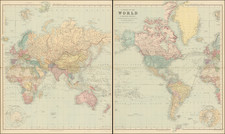
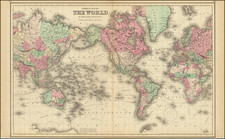
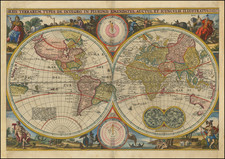
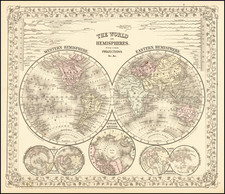
![Apollo Earth Orbit Chart (AEO) Apollo Mission 8. Sheet 1 of 3, Contains Revolution 1. For December 1968 Launch Dates [with:] Sheet 2 of 3, Contains Revolution 2. For December 1968 Launch Dates [and: Sheet 3 of 3, Contains Revolution 3. For December 1968 Launch Dates]](https://storage.googleapis.com/raremaps/img/small/95707.jpg)
